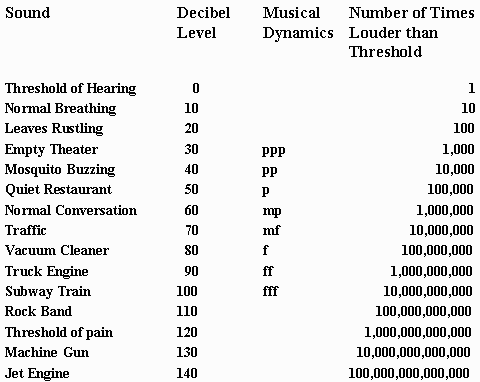


| Title: | Location | K-4 | 5-8 | 9-12 | Description | Discipline |
| Dynamics & Expression | SoundGarden | How is music like a language? |
Have you ever noticed how hard it is to understand someone when they speak too softly or too loudly for that matter? That's because there's a certain range of loudness we use to communicate ideas through language and music.
OK, now try saying the following sentence out loud, go ahead nobody's listening:
"I fell asleep and dreamt that I was a saxophone."
Now try saying the same sentence but add say the words 'I' and 'that' much louder. Try it again and say the words 'fell asleep' and 'saxophone' very softly. What changes? Well, the meaning changes somewhat, based on how loud each word is. Loudness of softness places an emphasis on each word that can change its meaning.
The same is true in music. If you have an instrument available or you wish to sing, you can do the same exercise but with a scale or a melody.
Listen to This!
Listen to the following melodies.
 (19") – Melody #1 - The Star Spangled Banner.
(19") – Melody #1 - The Star Spangled Banner. (13") – Melody #2 - Euterpe's SoundGarden Theme.
(13") – Melody #2 - Euterpe's SoundGarden Theme.
 (07") – Melody #3 - Schoenberg Opus 25, Mvt. V.
(07") – Melody #3 - Schoenberg Opus 25, Mvt. V.
Now listen to them again with changes in loudness.
 (19") – Melody #1 - The Star Spangled Banner with dynamic changes (crescendo then decrescendo).
(19") – Melody #1 - The Star Spangled Banner with dynamic changes (crescendo then decrescendo). (13") – Melody #2 - Euterpe's SoundGarden Theme with dynamic changes (decrescendo then crescendo).
(13") – Melody #2 - Euterpe's SoundGarden Theme with dynamic changes (decrescendo then crescendo).
 (07") – Melody #3 - Schoenberg Opus 25, Mvt. V with dynamic changes (crescendo).
(07") – Melody #3 - Schoenberg Opus 25, Mvt. V with dynamic changes (crescendo).
What changes? Write down your definition of musical dynamics in your journal. Use descriptive words that show what the differences in loudness do to the feeling or expressiveness of a melody.
Hands-On Activity – Explore the Loudness Zone!

Materials needed:
- A musical instrument or one that you've made yourself.
- Your journal.
To Do:
- Pick a favorite melody that you already know (you can use one the three you've already worked with above). Play the melody on your instrument, or if you like, sing, whistle, or hum it several times.
- Next, try a play or sing it with a gradual crescendo. In other words, begin very softly, almost at a whisper and gradually get very loud.
- Now do the opposite with a decrescendo. Begin very loud and gradually get softer so that you end on a whisper.
- This time, begin very softly and perform a crescendo towards the middle of the melody, then perform a descrescendo so that you end very softly.
- For the grand finale, begin very loud perform a decrescendo towards the middle of the melody, then perform a crescendo and finish with the loudest level yet!
- Finally, write a sentence that expresses the same feeling as your melody. If your melody is happy, or sad, or exciting, write a sentence that captures that feeling (you can use the words from a song or a poem too).
What's the Point?
The human ear is sensitive to an amazingly wide range of loudness, or in musical terms, dynamics. Scientists measure sound in a range that's over one trillion units! That's a one and twelve zeroes!
Musicians and composers use musical dynamics for expressive purposes. Two of the most popular kinds are called:
- the crescendo (getting gradually louder)
- the decrescendo (getting gradually softer)
They are used to create striking effects, particluarly with a full orchestra or with a band that uses amplified instruments.

Human Hearing Range for Loudness
The above chart displays the large range of loudness for musical dynamics. There is also musical notation for dynamics on the chart. The 'p' stands for the term piano (which means soft in Italian), and 'f' stands for forte (which means loud). Do you know what the 'm' stands for (hint: look up the Italian word 'mezzo')?
Just for Fun!
Let's explore some other variations in musical expression with dynamics.
- First, take an existing melody and compose your own set of words (for example, the Little Mermaid, Twinkle Twinkle, etc.).
- Now try to add effects such as a suddenly loud or soft sound.
- Try to use a crescendo and decrescendo too.
- When you're done, perform it for a friend. If you have a tape recorder available tape your performance so you can demonstrate where the dynamics occur.
- Finally, write your reflections about musical dynamics in your journal.
"Sing unto him a new song;
play skillfully with a loud noise."
– Book of Psalms
Send your comments to: webteam@cafemuse.com
© 1996 – 2015 NewWorldView, All Rights Reserved.